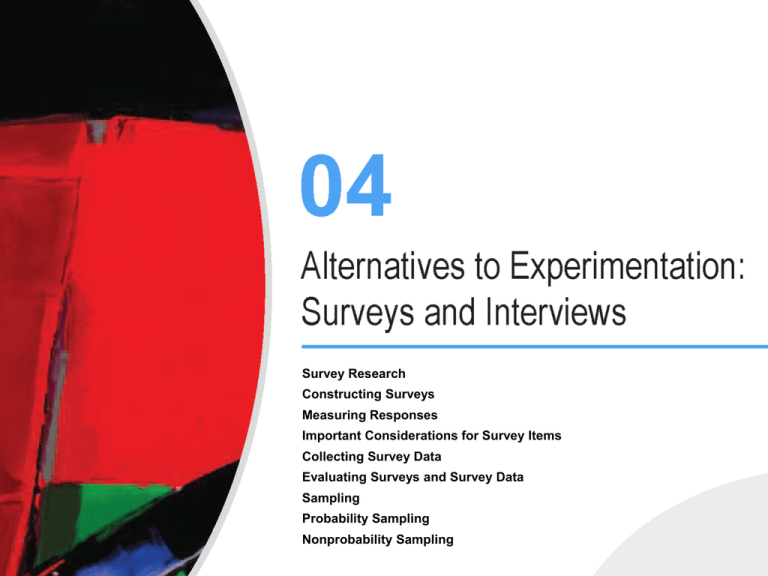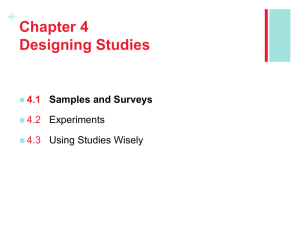Chapter 4.
advertisement

Survey Research Constructing Surveys Measuring Responses Important Considerations for Survey Items Collecting Survey Data Evaluating Surveys and Survey Data Sampling Probability Sampling Nonprobability Sampling Describe survey research. Survey research obtains data about opinions, attitudes, preferences, and behaviors using questionnaires or interviews. The survey approach allows researchers to study private experience, which cannot be directly observed. Survey Research What are the advantages of the survey approach? We can efficiently collect large amounts of data. Anonymous surveys can increase the accuracy of answers to sensitive questions. Surveys can allow us to draw inferences about the causes of behavior and can complement laboratory and field experiments. Survey Research What is the most important limitation of the survey approach? The survey approach does not allow us to test hypotheses about causal relationships because we do not manipulate independent variables and control extraneous variables. Survey Research What are the major steps in constructing surveys? 1. Identify specific research objectives. 2. Decide on the degree of imposition of units (degree of response restriction). 3. Decide how you will analyze the survey data. Constructing Surveys Describe the major question types. Closed questions (structured questions) can be answered using a limited number of alternatives and have a high imposition of units. For example, “How many songs did your roommate illegally download this month?” Constructing Surveys Describe the major question types. Open-ended questions (open questions) require that participants respond with more than a yes or 1-10 rating and have a low imposition of units. For example, “Why did your choose your major?” Constructing Surveys How do researchers analyze data from each question type? The number or percent of responses can be reported for closed questions. Open-ended questions can be analyzed using content analysis, like Yepez’s INTERSECT, in which responses are assigned to categories using objective rules. Constructing Surveys What are three concerns when constructing questions? 1. Keep items simple and unambiguous, and avoid double negatives. 2. Avoid double-barreled (compound) questions that require responses about two or more unrelated ideas. 3. Use exhaustive response choices. Constructing Surveys Describe a nominal scale. A nominal scale assigns items to two or more distinct categories that can be named using a shared feature, but does not measure their magnitude. For example, you can sort professors into exciting and dull categories. Measuring Responses Describe an ordinal scale. An ordinal scale measures the magnitude of the dependent variable using ranks, but does not assign precise values. For example, marathon contestants may finish from first place to last place. Measuring Responses Describe an interval scale. An interval scale measures the magnitude of the DV using equal intervals between values with no absolute zero point. For example, Fahrenheit or Centigrade temperatures, and Sarnoff and Zimbardo’s (1961) 0-100 scale. Measuring Responses Describe a ratio scale. A ratio scale measures the magnitude of the dependent variable using equal intervals between values and an absolute zero. This scale allows us to state that a 2-meter board is twice as long as a 1-meter board. For example, distance in meters. Measuring Responses How should we select measurement scales? The best type of scale depends on the variable you are studying and the level of precision you desire. Since psychological variables like traits, attitudes, and preferences represent a continuous dimension, several levels of measurement “fit” equally well. Measuring Responses How should we select measurement scales? When working with variables like sociability, psychologists often select the highest scale since it provides more information and allows analysis using more powerful statistics. Measuring Responses What should you consider when creating survey items? Subjects decide to refuse to answer surveys during the start or first few questions. Engage subjects from the start by asking interesting questions they will not mind answering. Important Considerations for Survey Items What should you consider when creating survey items? The first survey question should be: 1. relevant to the survey’s central topic 2. easy to answer 3. interesting 4. answerable by most respondents 5. closed format Important Considerations for Survey Items What should you consider when creating survey items? Whenever possible, use commonly used response options. Avoid value-laden questions that might make a response seem embarrassing. Important Considerations for Survey Items What is a response style? Response styles are tendencies to respond to questions or test items without regard to their actual wording. People differ in their willingness to answer, position preference, and yea-saying and naysaying. Important Considerations for Survey Items Explain the willingness to answer response style. Willingness to answer is the tendency to guess or omit items when unsure. Important Considerations for Survey Items Explain the position preference response style. Position preference is selecting an answer based on its position. For example, students choosing “c" on multiplechoice exams. Important Considerations for Survey Items What is manifest content? Manifest content is the plain meaning of the words printed on the page. While we expect subjects to respond to the manifest content of questionnaires, they may ignore it when answering questions about their feelings or attitudes. Important Considerations for Survey Items What are yea-saying and nay-saying? Yea-saying is agreeing with an item regardless of its manifest content. Nay-saying is disagreeing with an item regardless of its manifest content. Important Considerations for Survey Items What are context effects? Context effects are changes in question interpretation due to their position within a survey. This problem is especially likely when two questions are related and not separated by buffer items (unrelated questions). Important Considerations for Survey Items Explain the social desirability response set. The social desirability response set is representing ourselves in a socially appropriate fashion when responding to a question’s latent content (underlying meaning). For example, you may dress formally for a job interview instead of wearing your favorite jeans. Collecting Survey Data Compare structured and unstructured interviews. In structured interviews, questions are asked the same way each time. This provides more usable, quantifiable data. In unstructured interviews, the interviewer can explore interesting topics as they arise. These data may not be usable for content analysis. Collecting Survey Data What is the relationship of a sample to its population? A population consists of all people, animals, or objects that share at least one characteristic. A sample is a subset of the population of interest (the population we are studying). Sampling What are two advantages of probability sampling over nonprobability sampling? 1. A probability sample is more likely to represent the population (external validity) than a nonprobability sample. 2. We know the exact odds of members of the population being included in our sample. This tells us whom the sample represents. Probability Sampling Which are the main probability sampling methods? The four main probability sampling methods are: simple random sampling systematic random sampling stratified random sampling cluster sampling Probability Sampling Which are the main nonprobability sampling methods? The four main nonprobability sampling methods include: quota sampling convenience sampling purposive sampling snowball sampling Nonprobability Sampling








